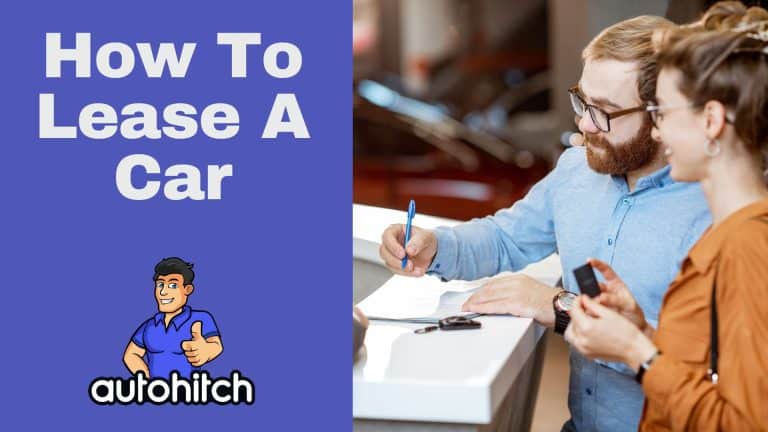Are you wondering if leasing is the right choice for your next car?
Leasing a vehicle instead of buying one offers some advantages, including lower monthly payments and always driving a newer car.
However, leasing isn’t ideal for all drivers and it might not be right for you…
This comprehensive guide explains everything you need to know to decide if leasing fits your lifestyle and budget.
Key Takeaways
- Leasing involves paying to drive a car you don’t own for 2-3 years on average
- Lower monthly costs but no equity and mileage limits compared to buying
- Need to return the car in good shape or risk large fees for repairs and wear & tear
Related Articles You Might Need To Read:
- How To Lease A Car Through Your Business
- How to lease a car with bad credit
- How Old Do You Have to Be to Lease a Car
- What Happens at the End of a Car Lease
- Is Car Insurance More Expensive When You Lease?
- What is a Car Lease Transfer?
- How To Get Out Of A Car Lease
Table of Contents
What is Car Leasing and How Does it Work?
You likely already understand the basic concept of leasing if you’re here,
But did you know the contract fine print contains over 20 key terms defining everything from interest rates to wear and tear policies?
Understand these intricate lease details, and you can masterfully negotiate an optimal deal.
Ignore or misunderstand them, and you may overpay or risk financial surprises. We’ll unpack what you really need to know about how leasing works below,
but, the biggest difference between buying vs leasing a car is that instead of building equity, you’re paying for depreciation plus fees and interest.
Should I Lease or Buy My Next Car?
Deciding between leasing and buying depends on your budget, driving needs, and preferences:
Pros of Leasing
- Lower monthly payments
- Always driving a newer car with latest tech
- Less long-term commitment
- Lower repair costs while leased
Cons of Leasing
- No equity or asset accumulation
- Strict mileage limits and penalties
- Responsible for excessive wear and tear
- Costly early termination fees
Leasing tends to work better for drivers wanting a new car every few years. Buying is usually better long-term for accumulating equity and avoiding recurring payments.
| Leasing | Buying |
|---|---|
| Lower monthly costs | Gain ownership and equity |
| Upgrade more frequently | Customize the car freely |
| Lessor handles maintenance | No mileage restrictions |
| Early termination penalties | Easier to get out of payments |
Key Takeaway
Leasing fits those wanting new cars often, buying those keeping cars longer. Choose based on budget, mileage needs and customization preferences.
What is Needed to Qualify for a Car Lease?
leasing a car typically requires:
- Good credit score – 680+ ideal, 600+ still possible
- Proof of income – Recent pay stubs or tax returns
- Valid driver’s license – Must match application info
- Auto insurance – Meeting state and lender requirements
Having good credit increases approval odds and secures better lease rates. Those with bad credit may need a larger down payment or cosigner to qualify.
Key Takeaway
You’ll need good credit, income proof, insurance and a license to qualify for most lease agreements.
How to Find the Best Car Lease Deals
Finding the most affordable lease involves researching vehicles, comparing offers and negotiating terms. Key steps include:
Choose Cars With Strong Residual Values
Since leasing payments are based on depreciation costs, opt for makes/models projected to retain value well. Kia, Honda and Toyota consistently rank well.
Use Pricing Guides to Estimate Fair Sale Prices
Consult Kelley Blue Book or Edmunds to determine reasonable pricing before negotiating. This allows you to recognise good lease offers.
Get Quotes from Multiple Local Dealers
Contact different dealerships to request lease quotes on identical vehicles. Compare out-the-door pricing side-by-side.
Negotiate the Capitalized Cost
The capitalized cost is essentially the sale price of the car. Negotiate this like you would when buying a vehicle.
Ask About Any Leasing Specials or Incentives
Manufacturers often subsidize leases on certain models with lower interest rates or rebates. Inquire about current promotions.
Use a Lease Calculator
Input your negotiated terms into an auto lease calculator to estimate total lease costs. Tweak numbers to find the optimal deal.
Key Takeaway
Finding the best lease requires picking good residual value cars, estimating fair pricing, gathering multiple quotes, negotiating cost, and using a lease calculator.
What is Included in a Car Lease Contract?
It’s essential to understand all aspects of your lease agreement before signing. Common key elements include:
- Monthly Payment – Based on depreciation, interest and fees
- Length of Lease – Typically 24-36 months
- Allowable Mileage – Average per year, usually 10k-15k
- Early Termination Fee – If ending lease before term
- Disposition Fee – Charged when returning the car
- Security Deposit – Refundable amount held by lessor
- Acquisition Fee – Upfront fee for initiating lease
- Money Factor – Equates to interest rate on leased amount
- Drive-Off Fees – Taxes, registration, etc. due upfront
- Wear and Tear Policy – Defines excessive damage
Understanding Lease Terms
| Term | Definition |
|---|---|
| MSRP | Manufacturer’s Suggested Retail Price – the vehicle’s full price; a starting point for negotiation. |
| Capitalized Cost | The actual lease price of the vehicle after negotiations – can be reduced by down payment or trade-in. |
| Residual Value | The estimated value of the car at lease end – higher residual values usually lead to lower monthly payments. |
| Money Factor | The interest rate on the lease, expressed as a decimal – to get the equivalent APR multiply by 2,400. |
| Mileage Allowance | The maximum allowed miles per year without incurring extra charges – usually ranges from 10,000 to 15,000 miles. |
| Excess Mileage Fee | The fee per mile over the agreed allowance – can significantly increase the cost of leasing. |
| Disposition Fee | Fee charged at lease-end for the vehicle’s return and preparation for resale. |
| GAP Insurance | Insurance that covers the gap between the lease payoff and car insurance payout in case of a vehicle total loss. |
Key Takeaway
Carefully read and understand all aspects of the lease contract before signing, including fees, deposits, interest rates and mileage limits.
Step-by-Step Guide to Leasing a Car
Follow these key steps when getting started with leasing your next car:
- Determine Needs and Set Budget – Consider lifestyle, mileage needs and affordability upfront
- Check Credit Score and Eligibility – Gives negotiating leverage and approval odds
- Research Vehicles and Compare Offers – Look for good deals on makes/models that fit needs
- Test Drive Top Choices – Ensure car meets expectations before committing
- Negotiate Terms and Get Quotes – Use data and competing offers to secure best pricing
- Review Agreement Details Closely – Verify contract matches negotiated deal before signing
- Maintain Good Standing During Lease – Make timely payments and follow maintenance schedule
- Prepare for Lease End – Decide to buy, swap cars or return well in advance
Key Takeaway
Leasing a car takes research, planning, budgeting, negotiating skills and contract vigilance to find the optimal deal.
Common Questions and Expert Tips
Walking through the leasing process for the first time can be confusing and overwhelming. Here are answers to some frequently asked questions:
1. Can I negotiate a car lease?
Yes, you can negotiate the vehicle price, interest rate, fees, mileage allowance and more. Use invoice pricing data and competing offers to support negotiations.
2. What credit score is needed to lease?
Prime lessees often have scores above 680. However, those with scores as low as 600 may still qualify with a larger down payment.
3. Should I make a down payment when leasing?
Minimizing down payments reduces risks, but larger ones can lower monthly costs. Contribute enough to get desired payment but avoid overpaying.
4. What if I drive over my mileage limit?
It’s best to overestimate your annual mileage to provide a buffer. If you exceed the cap, charges around $0.25/mile apply. Review options to prevent surprise fees.
5. Can I get out of my car lease early?
You can try to transfer your lease or refinance the buyout amount. However, hefty early termination fees often make this difficult. Defaulting severely damages credit.
Key Takeaway
Do your homework before leasing, carefully negotiate terms, budget for all costs, and have a backup plan to avoid getting stuck in an expensive lease agreement.
Lease-End Options
The end of a lease isn’t the end of the opportunities to gain or lose out financially. Although you are probably only at the beginning of your lease process, use the table below to briefly introduce yourself to the options you’ll have when your lease comes to and end.
| Lease-End Option | Description |
|---|---|
| Return the Vehicle | Hand back the car to the dealership with no further obligations, assuming there’s no excess wear and the mileage limit isn’t exceeded. |
| Lease Buyout | Purchase the car at a predetermined price as specified in the lease agreement. Useful if the market value is higher than the buyout price. |
| Extend Lease Term | Continue leasing the car for an agreed period – can involve new terms and potentially higher payments. |
| Early Lease Return | Return the vehicle before the lease ends, often involving penalty fees. |
| Lease a New Vehicle | Transition to a new lease, often with ease if staying with the same dealership or brand. |
Transferring Your Lease
If your circumstances change, you may want to get out of your lease early without penalties. One option is finding someone to take over your existing lease through a lease transfer.
Sites like swapalease.com and leasetrader.com can match you with interested parties for a fee.
You may need to offer incentives for anyone willing to assume a lease on a higher mileage vehicle.
Ensure you fully understand the transfer terms and that the leasing company removes your name from the contract before proceeding because there can be pitfalls and downsides.
Conclusion
Leasing can be a smart alternative to buying thanks to lower payments and upgraded cars every few years. However, restrictions around mileage, condition, and early termination make leases less flexible and more open to the possibility that you’re taken advantage of.
Drivers should weigh their budget, needs, and preferences before deciding to lease or buy.
Use the guidance in this article to negotiate optimal lease terms and avoid common pitfalls.



